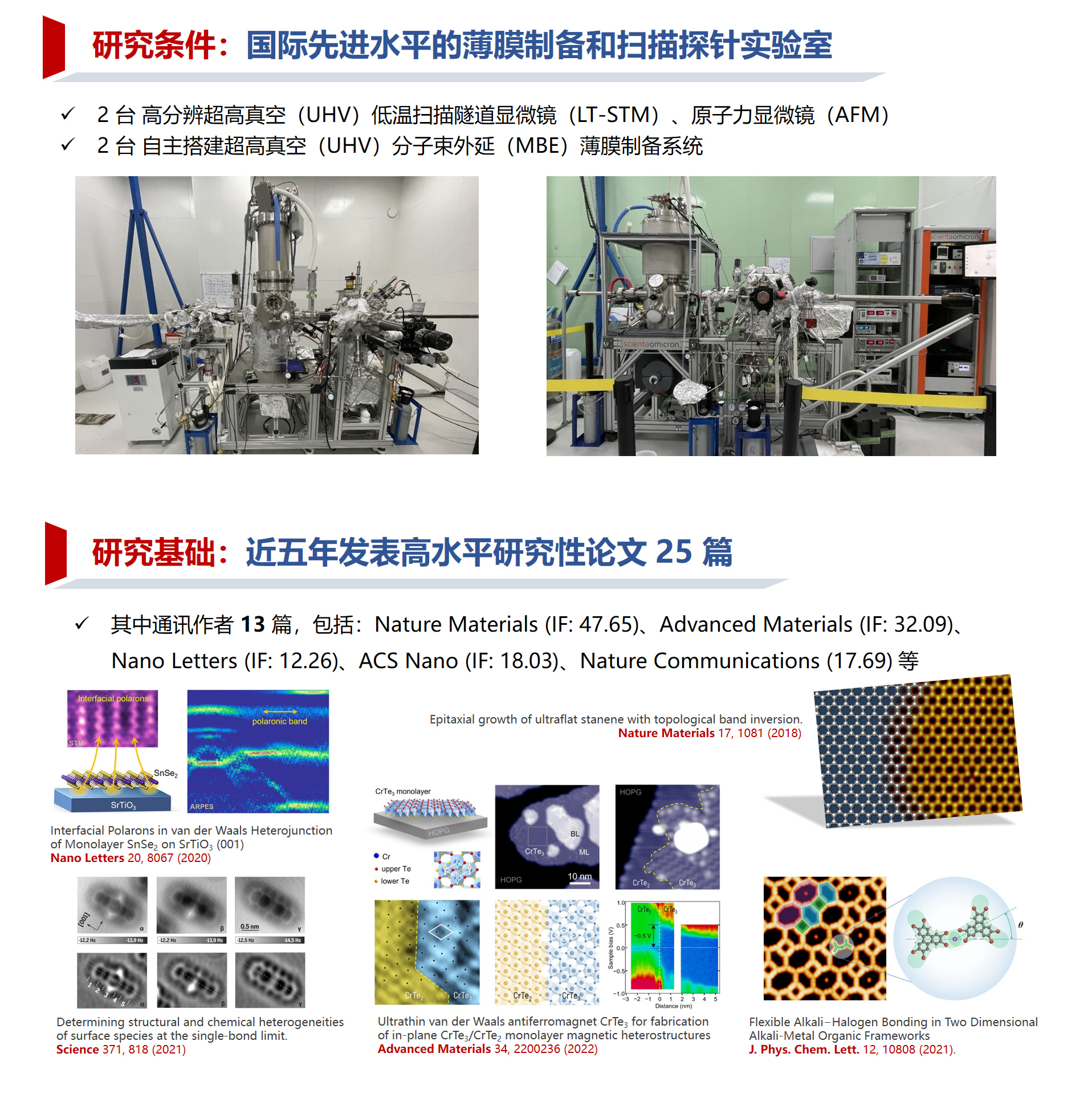原子级制造和表征实验室
|
原子级制造及高分辨表征:本课题组主要通过高精度的原位分子束外延和范德华外延技术、高分辨的描探针显微学及其谱学方法实现新型薄膜材料及其界面的原子精度制造并建立微观原子结构与宏观量子效应的构效关系。
课题组长赵爱迪教授长期从事单分子科学、高分辨扫描探针显微学、低维材料、分子束外延等领域的研究并取得多项原创性重要进展,在《Science》、《Nature Materials》、《Adv. Mater.》、《Nano Lett.》、《Nat. Commun.》等SCI 杂志上发表学术论文80余篇,撰写多篇专著章节,获得4项国家发明专利授权。研究成果曾获2005年中国十大科技进展、2009年全国高校十大科技进展。
本课题组长期招收研究生,待遇优厚,工作环境优越,欢迎有志于在低维材料及界面、薄膜材料、原子级制造设备及其产业化等领域开展最前沿研究的学生加入!有意者请直接与赵爱迪教授邮件联系。

Robust Topological Interface States in a Lateral Magnetic‐Topological Heterostructure, Small, 21, 2409979 (2025)
Nonreciprocal charge-density-wave proximity effect in a lateral heterojunction of NbSe2/TiSe2.Appl. Phys. Lett. 124 (7) 071602 (2024).
Interaction of water with ceria thin film.ChemCatChem 15 (15), e202300318 (2023).
Ultrathin van der Waals antiferromagnet CrTe3 for fabrication of in-plane CrTe3/CrTe2 monolayer magnetic heterostructures. Advanced Materials 34, 2200236 (2022).
Flexible Alkali−Halogen Bonding in Two Dimensional Alkali-Metal Organic Frameworks. J. Phys. Chem. Lett. 12, 10808 (2021).
Visualizing Band Profiles of Gate-Tunable Junctions in MoS2/WSe2 Heterostructure Transistors. ACS Nano 15, 16314 (2021).
Realization of Electron Antidoping by Modulating the Breathing Distortion in BaBiO3.Nano Letters 21, 3981 (2021).
Determining structural and chemical heterogeneities of surface species at the single-bond limit. Science 371, 818 (2021).
Observation of pseudogap in SnSe2 atomic layers grown on graphite. Front. Phys. 15, 43501 (2020).
Two-dimensional graphene-like Xenes as potential topological materials. APL Materials 8, 030701 (2020).
Creation of the Dirac Nodal Line by Extrinsic Symmetry Engineering. Nano Letters 20, 2157 (2020).
Transition from Semimetal to Semiconductor in ZrTe2 Induced by Se Substitution. ACS Nano 14, 835 (2020).
Reaction selectivity of homochiral versus heterochiral intermolecular reactions of prochiral terminal alkynes on surfaces. Nat. Commun. 10, 4122 (2019)
Epitaxial growth of ultraflat stanene with topological band inversion. Nature Materials 17, 1081 (2018).
Hidden Order and Haldane-Like Phase in Molecular Chains Assembled from Conformation-Switchable Molecules. ACS Nano 12, 6515 (2018).
Epitaxial growth of highly strained antimonene on Ag (111). Front. Phys.13, 138106 (2018).
Tuning the Doping Types in Graphene Sheets by N Monoelement. Nano Lett. 18, 386 (2018).
Molecule-Confined Engineering toward Superconductivity and Ferromagnetism in Two-Dimensional Superlattice. J. Am. Chem. Soc. 139, 16398 (2017).
Half-Metallic Behavior in 2D Transition Metal Dichalcogenides Nanosheets by Dual-Native-Defects Engineering. Adv. Mater. 29, 1703123 (2017).
Engineering hybrid Co-picene structures with variable spin coupling. Appl. Phys. Lett. 108, 171601 (2016). (APL Cover; Featured Article)
Surface Landau levels and spin states in bismuth (111) ultrathin films. Nat. Commun. 7, 10814 (2016).
Structural and electronic properties of an ordered grain boundary formed by separated (1,0) dislocations in graphene. Nanoscale 7, 3055 (2015).
Evidence of van Hove Singularities in Ordered Grain Boundaries of Graphene. Phys. Rev. Lett. 112, 226802 (2014).
Construction of carbon-based two-dimensional crystalline nanostructure by chemical vapor deposition of benzene on Cu(111). Nanoscale 6, 7934 (2014).
STM tip-assisted single molecule chemistry. Phys. Chem. Chem. Phys. 15, 12428 (2013).
Orbital-selective single molecule rectifier on graphene-covered Ru(0001) surface. Appl. Phys. Lett. 102, 163506 (2013).
Periodically Modulated Electronic Properties of the Epitaxial Monolayer Graphene on Ru(0001). J. Phys. Chem. C 115, 24858 (2011).
Controlling Electronic States and Transport Properties at the Level of Single Molecules. Adv. Mater. 22, 1967 (2010).
Optimal Electron Doping of a C-60 Monolayer on Cu(111) via Interface Reconstruction. Phys. Rev. Lett. 104, 036103 (2010).
Design and control of electron transport properties of single molecules. PNAS 106, 15259 (2009).
Mechanism for negative differential resistance in molecular electronic devices: Local orbital symmetry matching. Phys. Rev. Lett. 99, 146803 (2007).
Controlling the Kondo effect of an adsorbed magnetic ion through its chemical bonding. Science 309, 1542 (2005).
研究生:(专业、入学年份)
Akber Humaira(物理、国际留学生2017博)
牛群(材料、2019硕、2021博)、于立鑫(物理、2019硕、2022博)
宋先明(物理、2020硕、2022博)
宋全超(物理、2021硕、2023博)
王一博(材料、2023硕)
毕业研究生:
博士:(获学位年份、专业、去向)
姚杰(2022,物理化学,华虹半导体)
张静娴(2022,材料物理与化学,华虹半导体)
曹慧(2021,物理化学,美国阿贡国家实验室)
张志荣(2021,物理化学,中国科学技术大学)
毛亚会(2020,凝聚态物理,联合微电子)
单欢(2020,凝聚态物理,中国科学技术大学)
邓家良(2018,凝聚态物理,中国电科)
陈浩琪(2018,凝聚态物理,沃诚实业)
周春生(2016,凝聚态物理,南方科技大学)
硕士:(获学位年份、专业、去向)
韩钰(2023,凝聚态物理,费勉仪器)
吴金蓉(2019,物理,泛林半导体)
韩清华(2014,凝聚态物理,德国亚琛工业大学)
赵鑫(2013,凝聚态物理,招金期货)



